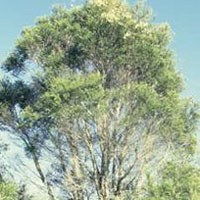health guides
Tea Tree

How It Works
The oil contains numerous chemicals known as terpenoids. Australian standards were established for the amount of one particular compound, terpinen-4-ol, which must make up at least 30% and preferably 40–50% of the oil for it to be medically useful. Another compound, cineole, should make up less than 15% and preferably 2.5% of the oil. The oil kills fungus and bacteria, including those resistant to some antibiotics.1, 2 For common acne, a double-blind trial compared the topical use of 5% tea tree oil to 5% benzoyl peroxide.3 Although the tea tree oil was slower and less potent in its action, it had far fewer side effects and was thus considered more effective overall.
A double-blind trial found that a 10% tea tree oil cream was as effective as anti-fungal medicine at improving symptoms associated with athlete’s foot, though it was not more effective than a placebo for eliminating the fungal infection.4 A double-blind trial found 100% tea tree oil applied topically was as effective as the anti-fungal medicine clotrimazole (Lotrimin®, Mycelex®) for people with fungus affecting the toe nails, a condition known as onychomycosis.5 In another double-blind trial with toenail fungus sufferers, a combination of 5% tea tree oil and 2% butenafine (Mentax®), a synthetic anti-fungal drug, in a cream proved more effective than an unspecified concentration of tea tree oil in cream alone.6 The results are not entirely surprising, as the tea tree product alone was probably not at a sufficiently high enough concentration to be effective.
A preliminary trial found that rinsing the mouth with 1 tablespoon (15 ml) tea tree oil solution four times daily effectively treated thrush (oral yeast infections) in AIDS patients.7 Solutions containing no more than 5% should be used orally and should never be swallowed.
A concern for hospital staff and patients is the spread of the bacteria Staphylococcus aureus—sometimes referred to as a “staph infection.” One small clinical trial found that use of a 4% tea tree oil nasal ointment as well as a 5% tea tree oil body wash was slightly more effective than standard drugs used to prevent the spread of the bacteria.8
How to Use It
Oil at a strength of 70–100% should be applied moderately at least twice per day to the affected areas of skin or nail.9 For topical treatment of acne, the oil is used at a dilution of 5–15%. Concentrations as strong as 40% may be used—with extreme caution and qualified advice—as vaginal douches. For thrush in immune-compromised adults, tea tree oil diluted to 5% or less is used in the amount of 1 tablespoon (15 ml) four times daily (as a mouth rinse). Tea tree oil should never be swallowed.
Copyright © 2024 TraceGains, Inc. All rights reserved.
Learn more about TraceGains, the company.
The information presented by TraceGains is for informational purposes only. It is based on scientific studies (human, animal, or in vitro), clinical experience, or traditional usage as cited in each article. The results reported may not necessarily occur in all individuals. Self-treatment is not recommended for life-threatening conditions that require medical treatment under a doctor's care. For many of the conditions discussed, treatment with prescription or over the counter medication is also available. Consult your doctor, practitioner, and/or pharmacist for any health problem and before using any supplements or before making any changes in prescribed medications. Information expires December 2024.


 We are proud to announce that
We are proud to announce that  As the market evolves, customers increasingly request a wider variety of omega-3 options for their lipid...
As the market evolves, customers increasingly request a wider variety of omega-3 options for their lipid...  Maintaining healthy glucose levels is crucial for preventing metabolic conditions like diabetes,...
Maintaining healthy glucose levels is crucial for preventing metabolic conditions like diabetes,...  Looking at formulating a new vitamin blend? Discover
Looking at formulating a new vitamin blend? Discover 







































